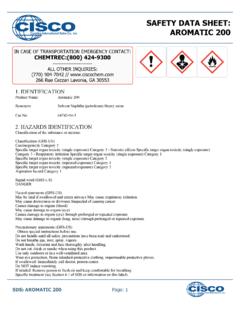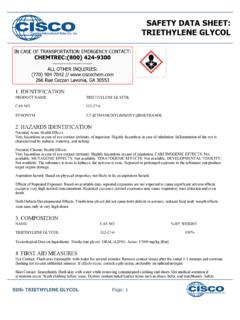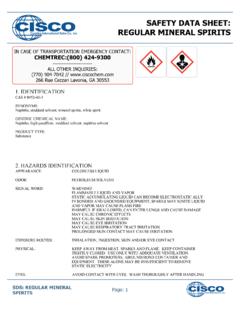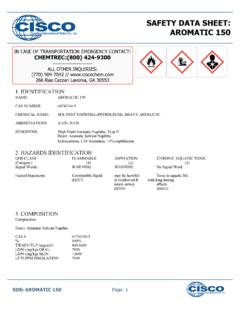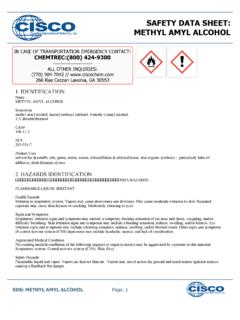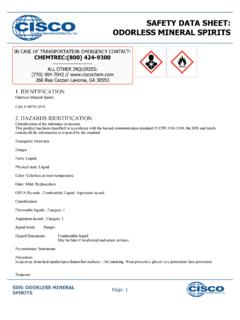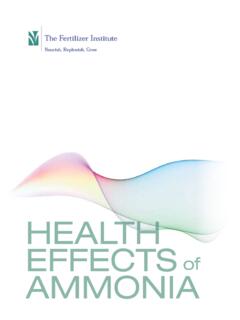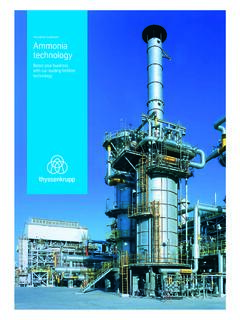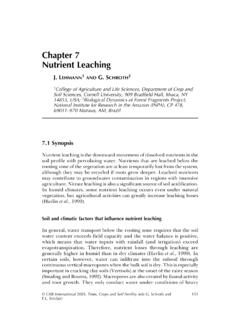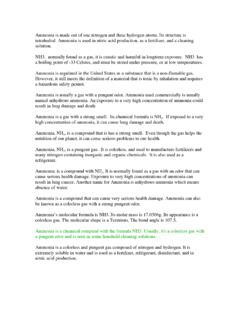Transcription of SAFETY DATA SHEET: UREA, DRY
1 SAFETY DATA SHEET: urea , DRY1. IDENTIFICATIONPRODUCT NAME: urea , DRYPRODUCT FORM:MIXTURESYNONYMS: urea GRANULAR; urea MICROPRILLS, urea PASTILLE; UREAPRILLSPRODUCT USES:AGRICULTURAL, INDUSTRIAL AND FEED GRADE CHEMICAL2. HAZARDS IDENTIFICATIONC auses skin irritation. Causes serious eye irritation. May cause respiratory breathing hands thoroughly after only outdoors or in a well-ventilated eye protection, protective gloves, protective gloves, protective ON SKIN: wash with plenty of waterIF INHALED: Remove victim to fresh air and keep at rest in a position comfortable for IN EYES: Rinse cautiously with water for several minutes. Remove contact lenses, if present and easy to do. Continue A POISON CENTER or doctor if you feel skin irritation occurs, get medication eye irritation persists, get medical off contaminated clothing!
2 Store in a well-ventilated place. Keep container tightly closed. Store locked of contents/container in accordance with local, regional, national and international hazards!Hazardous! to the aquatic environmentIN CASE OF TRANSPORTATION EMERGENCY CONTACT:CHEMTREC:(800) 424-9300-----------------------ALL OTHER INQUIRIES:(770) 904-7042 // Rue Cezzan Lavonia, GA 30553 Page: 1 SDS: urea , DRY3. COMPOSITIONMIXTURES:NAMECAS #% BY WEIGHTGHS-US CLASSIFICATIONUrea [Carbamide, IRRIATION 2 Carbonyldiamide, Carbamidic Acid)EYE IRRIATION 2 AAlkalinity, as Ammonia7664-41-7150 ppm (max) Irritant Irritant 24. FIRST AID MEASURESFIRST AID MEASURES GENERAL:If medical advice is needed, have product container or label at AID MEASURES AFTER INHALATION:If inhaled, remove from source of exposure to fresh air and keep at rest in a position comfortable for breathing.]
3 Give oxygen orartificial respiration if necessary. Obtain medical attention if breathing difficulty persists. Symptoms may be AID MEASURES AFTER SKIN CONTACT:Wash skin thoroughly with mild soap and water. For contact with molten product, do not remove clothing. flush skin immediatelywith cold water. Obtain medical attention if irritation develops or persist. Wash contaminated clothing before AID MEASURES AFTER EYE CONTACT:Immediately rinse with water for a prolonged period (15 minutes) while holding the eyelids open to ensure thorough rinsing. Obtainmedical attention immediately if irritation develops or AID MEASURES AFTER INGESTION:Do not induce vomiting. Keep affected person warm and treat for shock. A single dose of 100 grams has reportedly caused mildsymptoms of Central Nervous System depression (drowsiness, etc).
4 Seek medical attention if a large amount if swallowed. Getmedical advice and attention if you feel IMPORTANT SYMPTOMS AND EFFECTS, BOTH ACUTE AND DELAYEDS ymptoms/injuries:Irritation to eyes, skin and respiratory after inhalation:Overexposure may be irritating to the respiratory after skin contact:May cause skin after eye contact:May cause eye after ingestion:If a large quantity has been ingested: Abdominal Nausea. Vomiting. May cause drowsiness andloss of FIRE FIGHTING MEASURESEXTINGUISHING MEDIAS uitable extinguishing media:Not considered flammable but will burn at hightemperatures. Use extinguishing media appropriate forsurrounding extinguishing media:None knownSPECIAL HAZARDS ARISING FROM THE SUBSTANCE OR MIXTUREFire Hazard:Decomposes above C ( F) Under conditions oof fire this material may produce: Ammonia; NitrogenPage: 2 SDS: urea , DRYoxides; Biuret.
5 Short-term exposures to smoke and gasesmay lead to irreversible lung injury without early signs hazard:Product is not explosive. May form explosive mixtures ifmixed strong acid (Nitric/Perchloric) and strong :Stable at ambient temperature and under normal conditionsof FOR FIREFIGHTERSF irefighting instructions:Not flammable. Material burns with difficulty. Ureabecomes slippery when wet - guard against slips and during firefighting:Wear full fire fighting turn-out gear (full Bunker gear) andNIOSH approved respiratory protection (SCBA) with fullface piece and protective clothing. May form explosivemixtures if mixed with strong Information:Do not allow run-off from firefighting to enter drains orwater courses. Provide local or general ventilation to keepbelow nuisance dust ACCIDENTAL RELEASE MEASURESPERSONAL PRECAUTIONS, PROTECTIVE EQUIPMENT AND EMERGENCY PROCEDURESG eneral measures: Handle in accordance with good industrial hygiene and SAFETY NON-EMERGENCY PERSONNELP rotective equipment:Wear suitable protective clothing, gloves and eye/face protection including tight fitting of goggles to prevent eye contact.
6 Do notwear contact lenses when working with this substance. Normally no respiratory equipment needed. Use NIOSH approvedequipment when airborne dust exposure limits are exceeded. NIOSH approved breathing equipment must be available for nonroutine emergency procedures:If possible stop flow of product. Contain and collect as any solid. Ventilate unnecessary PRECAUTIONS:If spill could potentially enter waterway, including intermittent dry creeks, contact the US Coastguard National Response Center at 1-800-424-8802. In case of accident or road spill notifiy CHEMTREC at 1-800-424-9300. In other countries call CHEMTREC at(international code) + AND MATERIAL FOR CONTAINMENT AND CLEANING UPFor Containment:If contaminated with other material, contain and collect as any solid in suitable containers.
7 Do not allow into drains or water coursesor dispose of where ground or surface waters may be affected. Prevent large quantities from contacting FOR CLEANING UPRecover the product by vacuuming, shoveling or sweeping and place in appropriate container to be disposed at an appropriatedisposal facility according to current applicable laws and regulations ad product characteristics at the time of disposal. Provideadequate ventilation. Avoid generation of dust during clean-up of spills. If uncontaminated, recover and reuse the : 3 SDS: urea , DRY7. HANDLING AND STORAGEPRECAUTIONS FOR SAFE HANDLINGH andle in accordance with good industrial hygiene and SAFETY procedure. Wear recommended personal protective creating or spreading MEASURESE mergency eye wash fountains should be available in the immediate vicinity of any potential exposure.
8 Avoid contamination withother "look alike" materials that may produce a fire or FOR SAFE STORAGE, INCLUDING ANY INCOMPATIBILITIESS torage ConditionsStore tightly closed in a dry, cool and well-ventilated place away from heat, sources of ignition, and incompatibilities. Protect frommoisture. Avoid contamination with other "look alike" materials that may produce a fire or materialsAvoid containers, piping or fittings made of brass, bronze or other copper bearing alloys or galvanized END USE(S)Agricultural chemical8. EXPOSURE CONTROLS AND PERSONAL PROECTIONUREA (57-13-6)USA ACGIH (nuisance dust)ACGIH TWA (mg/m3)10 mg/m3 - inhalation particulateUSA OSHA (nuisance dust)OSHA PEL (TWA) (mg/me) 5 mg/m3 - respirable particulateEXPOSURE CONTROLSA ppropriate engineering controls:Ensure adequate ventilation, especially in confined areas to keep below nuisance dust limit of 15 protective equipment:Gloves, SAFETY glasses, Protective ClothingHand Protection:Impermeable protective glovesEye Protection:Protective gogglesSkin and body protection:Emergency eye wash fountains and SAFETY showers should be available in the immediate vicinity of any potential exposure.
9 Wearsuitable protective clothing. Wash contaminated clothing before resuse. Handle in accordance with good industrial hygiene andsafety Protection:Use NIOSH-approved air purifying or supplied air respirator where airborne concentrations of dust are expected to exceed exposurelimits. NIOSH approved breathing equipment must be available for non-routine and emergency exposure controls;Ensure adequate ventilation, especially in confined PHYSICAL AND CHEMICAL PROPERTIESP hysical state SolidAppearanceGranulesPage: 4 SDS: urea , DRYC olorWhiteOdorSlight AmmoniaOdor thresholdNo data at 100 g/LMolecular evaporation rate no data available(butyl acetate=1)Melting point Decomposes above C ( F)Freezing pointNo data availableBoiling pointNo data availableFlammability(solid,gas) Non - flammableFlash point no data availableSelf-ignition temperatureno data availableDecomposition temperatureno data availableVapor pressure 80 Pa at 20 CRelative vapor density at 20 Cno data g/cm3 Bulk density44 - 49 g/l at 25 CLog @ 20 C10.
10 STABILITY AND REACTIVITYREACTIVITYS table at ambient temperature and under normal conditions of STABILITYS table at standard temperature and pressurePOSSIBILITY OF HAZARDOUS REACTIONSH azardous polymerization will not occurCONDITIONS TO AVOIDP rotect from moisture. May slowly hydrolyze to ammonium carbamate and eventually decompose to ammonia and carbon dioxideINCOMPATIBLE MATERIALSMay form explosive mixture if in contact with strong acid such as nitric or perchloric acids. Avoid contact with strong oxidizers;strong acids or bases; nitrates; hypochlorities. Reacts with sodium or calcium hypohlorite to form explosive nitrogen : 5 SDS: urea , DRYHAZARDOUS DECOMPOSITION PRODUCTSU nder conditions of fire this material may produce: Nitrogen oxides; Ammonia; Biuret; Carbon oxides11.
